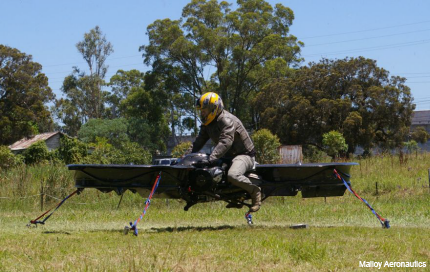Army developing a 'flying motorcycle' for the battlefield
ARL and two companies are adapting the Malloy hoverbike for tactical recon and troop transport, for use as a cheaper, more agile option to helicopters.

The hoverbike during a tethered, manned test.
In a few years, U.S. ground forces could be zipping around the battlefield on hoverbikes that might bring to mind the speeder bikes in “Return of the Jedi.”
The Army Research Laboratory recently completed a nine-month feasibility study on using a hoverbike, which it calls a tactical reconnaissance vehicle, or TRV, for a variety of purposes, including helping soldiers escape ground threats, and said the results were promising. Over the next three to five years, ARL said, it will work with U.K.-based hoverbike maker Malloy Aeronautics and Maryland-based defense company Survice Engineering to produce fill-size prototypes.
Malloy has posted this video of then hoverbike in action on YouTube.
In the field, hoverbikes, which Malloy calls the “the world’s first flying motorcycle,” could perform a set of combined helicopter/drone roles. At last month’s Paris Air Show, Mark Butkiewicz of Survice told Reuters that the Defense Department is interested because of the hoverbike’s flexibility in multiple roles. “It can transport troops over difficult terrain and when it's not used in that purpose it can also be used to transport logistics, supplies, and it can operate in both a manned and unmanned asset. It can also operate as a surveillance platform," Butkiewicz said.
A couple of other advantages he cited: Hoverbikes, or TRVs, would cost less to field than helicopters, they can navigate tighter spaces, and because their rotors are adducted (or covered) they’re safer, both being less of a threat to people near them and less likely to be brought down if they bump into something.
Malloy, which has been funding its hoverbike’s development though a Kickstarter campaign, has been working on the design for several years. Its original design was for a bi-copter with two rotors (perhaps a little more reminiscent of the “Star Wars” speeders), but that was eventually abandoned in favor of a quad-copter model, but with the front and rear rotors each overlapping to give the hoverbike a narrower profile.
ARL calls it a “disruptive technology” that could give soldiers increased mobility, mitigate ground threats and even lighten the loads soldiers have to carry. And, of course, the military likes the manned-or-unmanned option as well as its ability to perform ISR (intelligence, surveillance and reconnaissance).
With Survice, which has worked with DOD on various projects for 30 years, Malloy and ARL to work to get the hoverbike up to military standards. Aside from military use, the companies say the vehicle could serve other purposes, such as search and rescue, disaster response, agricultural tasks. (And who knows, maybe Amazon will use it for deliveries.)
Although ARL currently is in charge of the project, the Army said that, as the TRV concpt is developed, it could be moved to another organization within the Research, Development and Engineering Command.
NEXT STORY: Phishing scam poses as OPM hack notifications



